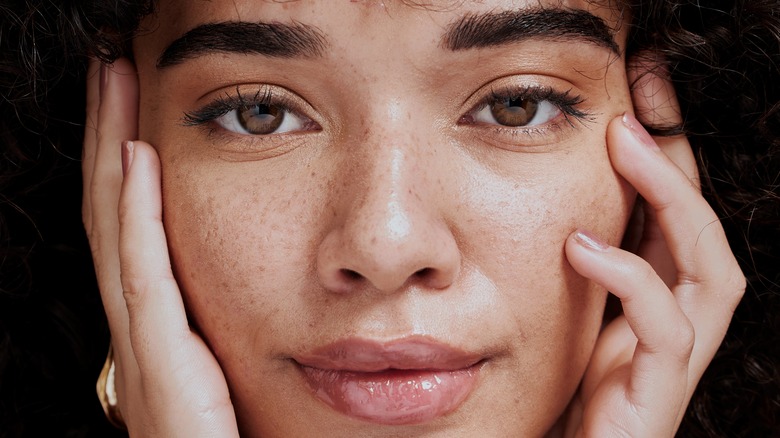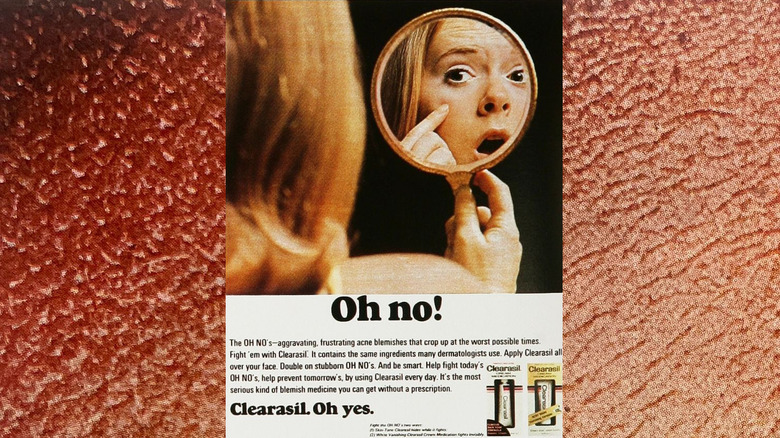Why Skin Texture's Slow Resurfacing In Beauty Ads Is So Important
Love 'em or hate 'em, we all have pores. Countless products and articles have targeted pores in a negative way, though they serve a very valuable function. Despite the widespread contempt for textured skin, these tiny indents help the skin to "breathe." So, why are they considered the enemy in beauty advertising?
Anyone who's scrolled through social media has witnessed models in cosmetic spots with curiously poreless and blurred complexions, and it doesn't stop at video marketing, either. Whether walking by the beauty aisle or flipping through a magazine, it's hard to find a trace of skin texture in modern beauty advertising. Beauty culture critic Jessica DeFino claims things are so bad that "cyborg skin" is her trend prediction for 2023. "Inspired by Metaverse avatars, AI art, and the democratization of photo-editing software, cyborg skin will seek to flatten any and all signs of life (wrinkles, pimples, pores) into a one-dimensional approximation of perfection: skin with no deviation in tone or texture, finished with a screen-like sheen..." DeFino told The Face.
For many, viewing unrealistically smooth skin in print and video ads can trigger feelings of insecurity or, worse, body dysmorphia. But it wasn't always this way. Beauty advertisements of the past didn't shy away from showing real, unretouched skin on models — and visible pores were once encouraged in makeup artistry circles. If it's true that everything old becomes new again, could realistic skin texture be the next trend to make a comeback?
The erasure of skin texture in advertising
Filters are ubiquitous in today's world, from TikTok's controversial, AI-inspired beauty tools to barely-there Instagram filters that gently smooth so-called imperfections. And while it might feel like new technology, the use of filters in photography and videography has existed for decades. Still, even silent film-era makeup artists didn't care to hide pores on screen. "Your pores should show as clearly as they normally do before you are ready to go beyond the grease paint," actor Raymond Hatton wrote in the 1922 guidebook "Opportunities in the Motion Picture Industry."
In terms of beauty ads, things began innocently enough. Some of the earliest cosmetic companies used simple line drawings in newspapers and magazines to promote their wares, later making the switch to incorporate real-life models. For a time, it wasn't unusual to see evidence of unedited skin in such photos. A 1969 Playtex ad, for example, depicted a model with plainly visible pores and creased makeup, implying skin texture was nothing out of the ordinary, even for glamor girls. By the 1980s, however, the rules for beauty standards became more tightly defined than a sharp cat eye. "Remember, when you're outdoors, the only thing anybody wants to see is a pretty face — not what went into making it that way," Donna Mills said in her 1984 beauty special, "The Eyes Have It."
How unrealistic skin texture negatively affects us
Over time, the airbrushed aesthetic became a fixture of print and video beauty ads. After routine exposure to cosmetic commercials of the 1990s and 2000s, one thing became clear to modern beauty consumers: poreless skin was in. It may be impossible to erase one's pores entirely, but that didn't stop anyone from fantasizing about the idea. For proof of this, simply look at a piece of pertinent pop culture from the Y2K era: In an episode of MTV's hit 2000s show, "Daria," popular girl Quinn Morgendorffer told a cameraman, "If you can see any of my pores on camera, I'll kill you. I do not have pores, my pores are cute, my pores are tiny."
But the desire for unnaturally smooth skin hasn't waned in recent years. In fact, it may be more prevalent than ever if the hazy, blurred skin portrayed in contemporary cosmetic campaigns is any indication. "[I] saw a video ad for a makeup brand using heavily filtered video. So many comments of 'Why doesn't it look like this on me?' and 'What foundation is that?!' and it makes me mad," tweeted one beauty fan. Moreover, poreless skin in advertising isn't just misleading — it can also take a toll on our body image and mental health. A study published in the medical journal Clinics in Dermatology found that regularly viewing filtered content could lead to increased body dissatisfaction and unnecessary cosmetic treatments in patients with body dysmorphic disorder.
A return to authenticity in beauty advertising
The overwhelming emphasis on complexion perfection, from the glazed donut skincare trend to glass skin, has resulted in some serious backlash from the beauty community. On the InstagramReality subreddit, for example, over 1 million users gather to discuss the erasure of skin texture in advertising and online. "Young people are growing up thinking people naturally look perfect, [and] naturally look like they have flawless skin ... when that's not a reality," wrote one user. As a result, loathing your pores is a fairly widespread fixation for many, with "how to get rid of pores" recorded as a Google search trend as early as 2004.
Yet there may be a light at the end of the tunnel for those raised on impossibly perfect representations of skin in advertising. Authenticity is increasingly important to consumers and social media users, and several beauty brands have responded by dropping filtered content from campaigns. Bare Minerals, Fenty Beauty, and Olay are just a few big names that have vowed to reduce or eliminate filters and retouching in promotional materials. It could be some time before we see more companies fighting back against face-altering filters, but we'd say this is a step in the right direction.


